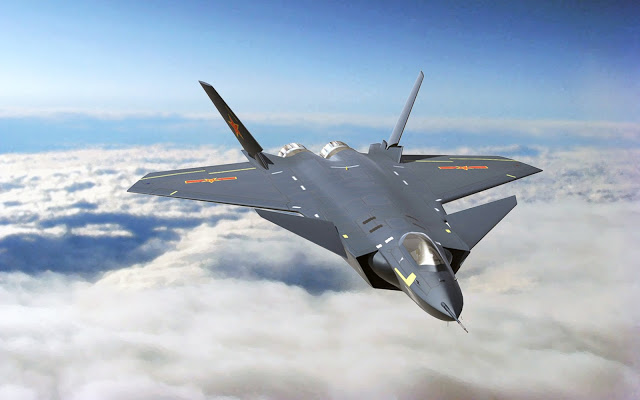China’s J-20 Black Eagle could be fully operational by 2018, and a second model, the J-31 Gyrfalcon, by 2020. If true, China’s new generation of fighters could have a substantial impact on its ability to either defend what it considers to be sovereign airspace, or to mount an aerial offensive in a wartime scenario, particularly against Taiwan (ROC).
An obscure engineer named Yang Wei has rapidly risen to the leadership of the Chengdu Aircraft Design Institute — a major warplane manufacturer responsible for quickly churning out Beijing’s top warplanes. He developed the J-20, China’s first stealth fighter (along with copied technology and information from Chinese hacking).
Still underpowered, with second rate stealth
China now builds fighters cheaply, quickly, and simply. However, China still has work to do to make a near-undetectable aircraft comparable to American designs — perhaps even Russian ones.
The J20 is underpowered considering its size and the fact that it wields twin AL-31F engines. Those engines are Russian and just a bit too weak for an aircraft that must balance speed and agility, which the J-20 appears to strive to do. Then there’s the electronics and fire-control systems, both areas where Chinese innovations are lacking.
The J-20 could acting as a long-range sniper, speeding directly toward U.S. reconnaissance planes and tankers … and shooting them out of the sky. Without those support assets in the air, America’s ability to wage war in the western Pacific drops dramatically.
Evolving designs
Chengdu has produced six prototypes. The designers are also taking J-20 and evolving it. The plane’s engine nozzles, one of the big giveaways to radar sweeps from behind, have been partially concealed on later prototypes. And Chengdu has apparently modeled its electro-optical targeting arrangement after the F-35. Other features, such as the front, resemble the U.S. F-22. That’s perhaps helped by data theft from America’s stealth fighter programs.
Plus, the J-20 will likely have an advantage over the F-35 in terms of speed and maneuverability owing to its large, delta wing design. What the J-20 lacks is a bigger, reliable engine.
The J20 is not a game-changing warplane. But in a little more than a decade, China went from having no stealth warplanes to entering the select club of countries in the fifth-generation fighter business.
China will spend $300 billion over the next 20 years to try to catch up on jet engines
US will keep dominant numbers of fighters through 2030
A late 2014 IHS forecast, the United States alone was projected to purchase 2,616 fifth-generation aircraft; a mixture of F-22s to be used by the Air Force and F-35 variants for the Air Force, Marines and Navy. NATO allies, specifically the United Kingdom, the Netherlands, Denmark, Norway, Italy, Turkey and Canada, are forecast to purchase more than 600 of these advanced planes. Other U.S. allies such as Japan, South Korea and Australia are also on track to procure approximately 300 such planes.
Rounding out the likely future purchases, Russia, China and India are expected to acquire more than 1,500 fifth-generation aircraft, intended to replace the Su-27, Su-30 and MiG-29 models, along with other indigenous aircraft.
This was before the likely cutback of T50s ordered by Russia and India.
It also assumes that the F35 will not be cancelled or significantly cutback in the 2020s.
The trend is downward as previously the expectation was 3200 fifth generation planes for the USA.

Brian Wang is a Futurist Thought Leader and a popular Science blogger with 1 million readers per month. His blog Nextbigfuture.com is ranked #1 Science News Blog. It covers many disruptive technology and trends including Space, Robotics, Artificial Intelligence, Medicine, Anti-aging Biotechnology, and Nanotechnology.
Known for identifying cutting edge technologies, he is currently a Co-Founder of a startup and fundraiser for high potential early-stage companies. He is the Head of Research for Allocations for deep technology investments and an Angel Investor at Space Angels.
A frequent speaker at corporations, he has been a TEDx speaker, a Singularity University speaker and guest at numerous interviews for radio and podcasts. He is open to public speaking and advising engagements.


